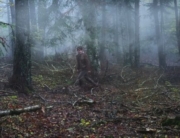In a city of eight million people—and eight million stories—filmmaker Crystal Moselle certainly stumbled across one of the most intriguing. Walking around the Lower East Side one day, she noticed a group of long-haired boys. Curiosity piqued, she followed them, and her interest only grew when she learned their backstory. The boys, all of whom had Hindu names (Bhagavan, Govinda, Narayana, Mukunda, Krsna, and Jagadisa) had lived most of their lives in their Lower East Side apartment. (The boys have an older sister, Visnu, who has Turner syndrome and whose presence in the film is minimal.)
Homeschooled by their mother and forbidden to leave their home by their father, they were entirely cut off from people outside their immediate family. Excursions were a once or twice a year indulgence, though the boys say that one year they never went out at all. Around 2010, the brothers began venturing out, realizing that their father’s hold on them was far more tenuous than they had thought. Moselle, who met them soon after, began to document their experience.
Despite their unusual upbringing, the boys, who now range in age from 23 to 16, are bright and inquisitive. Viewers who might be expecting dead-eyed zombies ready to drink the Flavor-Aid will be delighted to meet avid, almost obsessive film buffs, filling their days by watching and reenacting movies such as Reservoir Dogs, Goodfellas, and Pulp Fiction, making their own short films, and absorbing tons of film history and trivia. Granted, the brother’s actions feel like less of an interest and more of a cause (to quote Norman Bates, another homebound young man with an oppressive parent, “A hobby’s supposed to pass the time, not fill it”), but their life is a far cry from the Ariel Castro–esque hell some viewers will be anticipating.
Viewers eventually learn that the brothers’ bizarre, almost messiahlike father, Oscar, met their mother, Susanne, while she was traveling in Peru and that Oscar’s fear of their New York City neighborhood resulted in his forbidding the family to leave the apartment. However, viewers will come away with a lot of questions. What possessed the very Midwestern, down-to-earth Susanne to take up with the supposedly charismatic Oscar and never look back? (It’s been decades since she’s spoken to her own mother.) How is the family supporting itself? They receive stipends from the state for homeschooling, but beyond that, the source of their revenue is murky. Why do they live here, if they are so terrified of the world around them, rather than picking up and leaving?
Perhaps most of all, audiences will wonder how this father kept his brood in such an utter state of fear. Moselle doesn’t tell us precisely what was going on inside the apartment for so many years—though we get quite a few hints and sidelong references to both emotional and physical abuse. She clearly has a sense of affection, even love, for the boys. But she seems all too aware of the potential for exploitation. Indeed, the boys’ lives sound more like the premise for a Law & Order: Special Victims Unit episode or a TLC show (Hare Krishnas meet the Quiverfull movement). But Moselle resists the urge to parade her subjects before the camera, handling the subject delicately, maybe even too delicately: the film lacks the grounding and context that a more callous director might have given it.
The Wolfpack also feels weighed down by the sheer amount of all the material there is to handle. Where the film suffers is in its examination of each of the six brothers. They have their own distinct personality and reactions, yet viewers may become overwhelmed keeping track of them (think Fraulein Maria meeting the von Trapp kids for the first time).
Ultimately, Moselle has crafted an entirely new take on the coming-of-age story. There’s no sex, romance, or drugs. No dramatic screaming matches or fights. Yet the sense of rebelling, of breaking away, is palpable, as is the bond among brothers. The responses of these immensely appealing young people as they venture out into the world will resonate with even the most cynical of viewers. A scene where the boys compare the trees around them to a moment from the “Lord of the Rings” films combines their wide-eyed wonder with some typical teenage fanboying.
The sheer exhilaration that these boys experience from simply walking down the street, from a night going to the movies and coming back, is truly refreshing, and Moselle’s respect for her subjects is effective. She allows them a voice and gives them the chance to tell their stories. Indeed, the film is full of footage from the boys themselves, who are also credited as “additional camera.” Her interviews reveal moments of tenderness and vulnerability and shed light on the brothers’ genuinely fascinating way of seeing the world.
Audiences will want to see and hear more about these young people, and if they’re lucky, they will, and not in the form of a tawdry reality series or even a follow-up documentary but from the boys themselves. All are creative and thoughtful, and Govinda and Mukunda show a particular interest in filmmaking. Stirring and triumphant in spite of its flaws, this is a wholly original work that introduces some incredible new voices.

















Leave A Comment